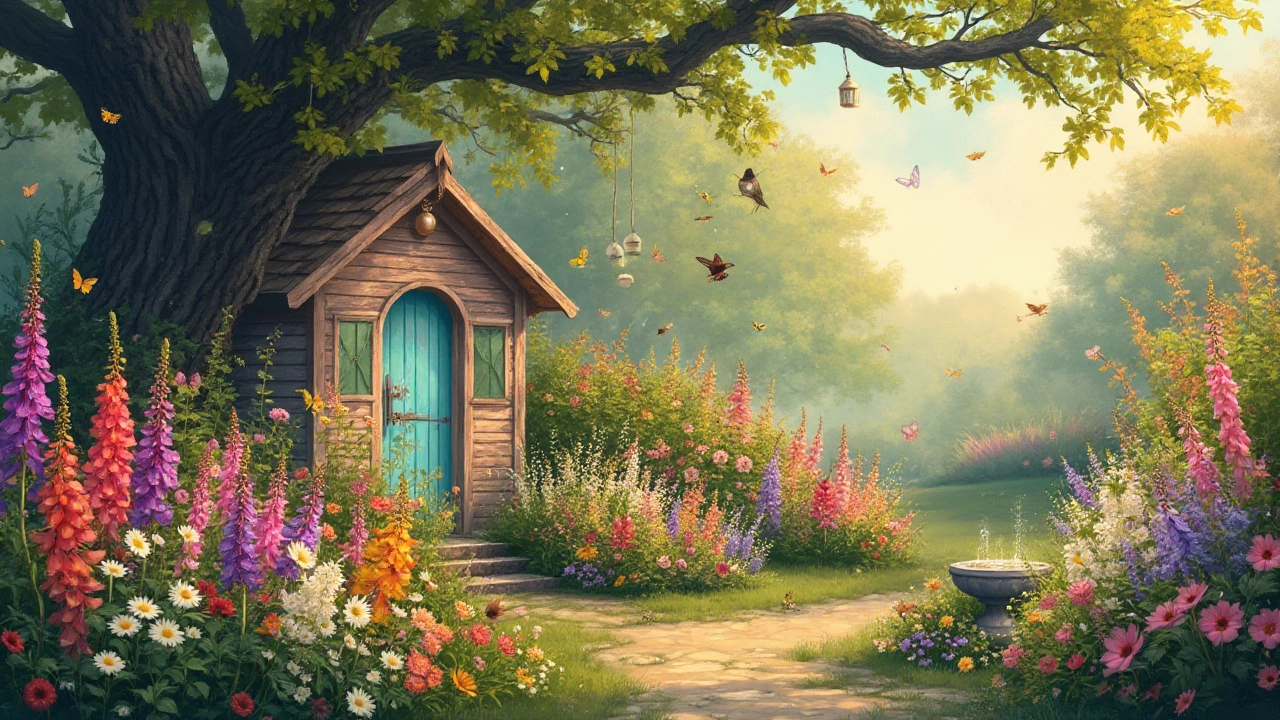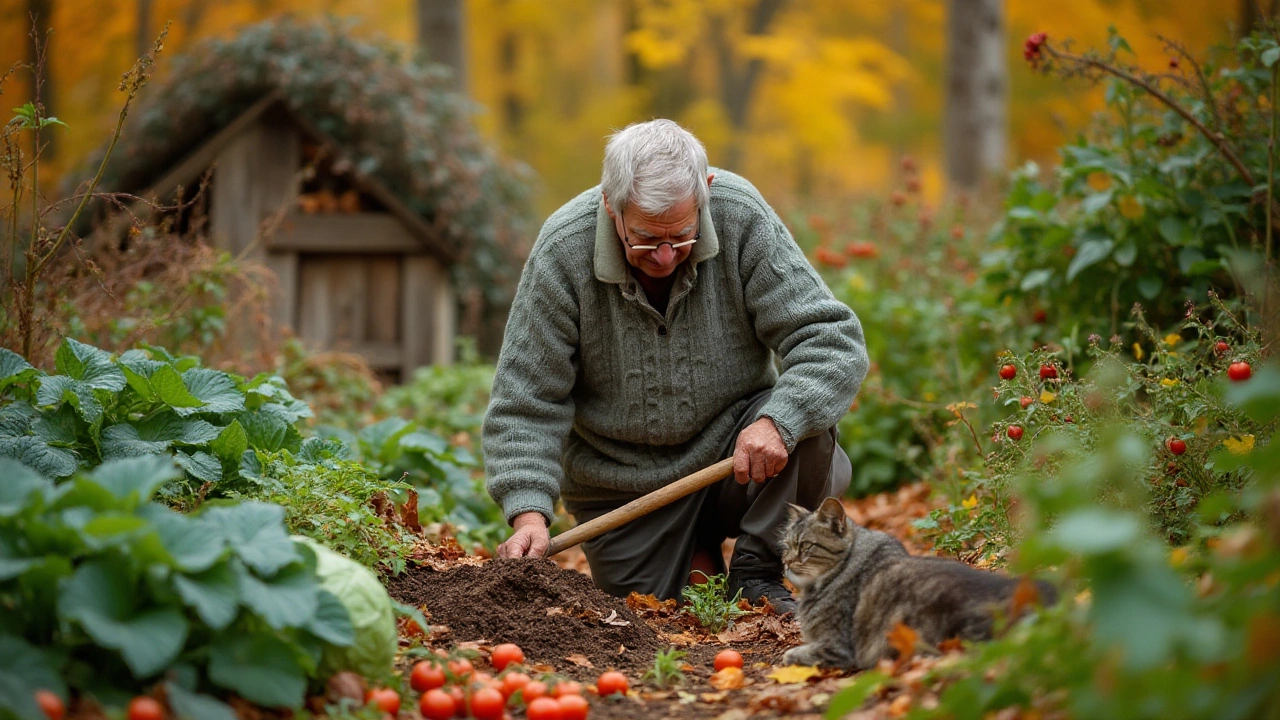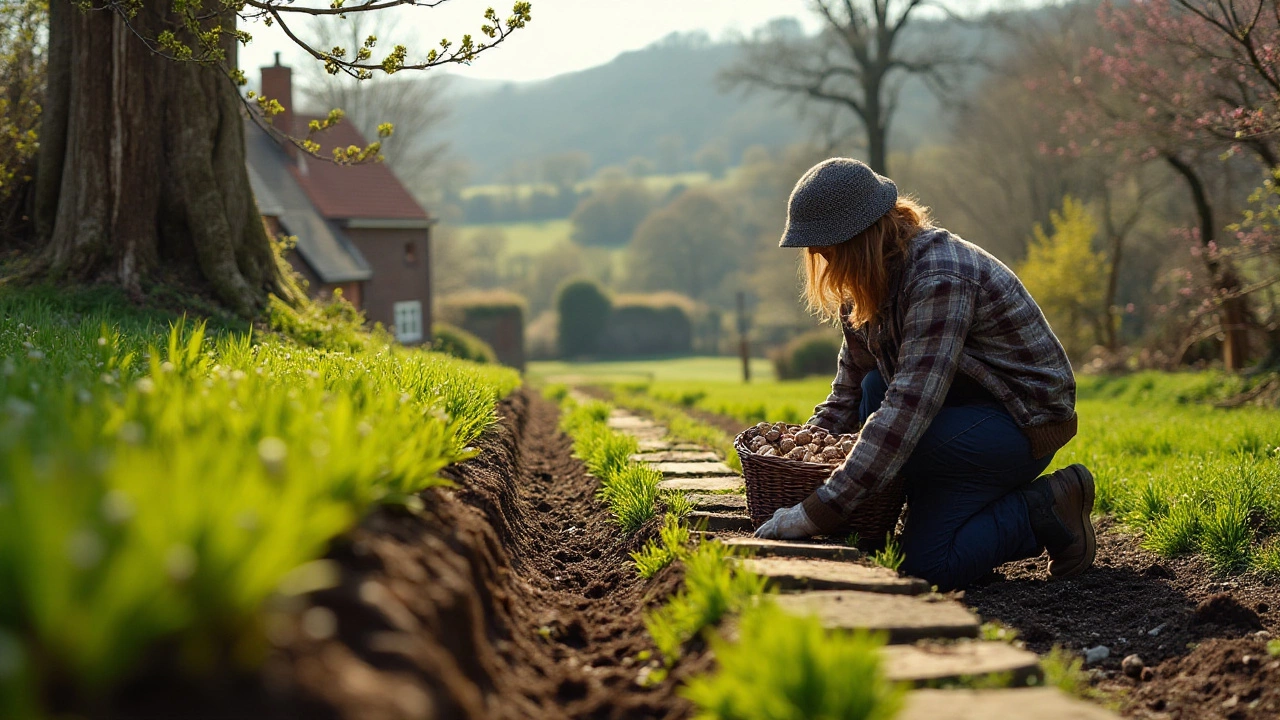Embarking on the journey of starting a garden is akin to painting on a blank canvas. It requires a blend of vision, planning, and a touch of patience. Whether you’ve got a sprawling backyard or a quaint patch of land, every space holds a unique potential to flourish with life and color.
The first step in this creative process is understanding the space you have. Every garden, irrespective of its size, has its own characteristics and merit. Recognizing what your specific plot can offer will set the stage for what can grow there.
Picking plants becomes more than just selecting vibrant blooms – it's about finding the right matches for your climate and soil to ensure they thrive. With this foundation, designing a layout becomes an exciting puzzle, fitting pieces like plant clusters, paths, and perhaps a sitting area, into an enchanting display.
Lastly, incorporating sustainability into your garden plan is not just trendy but essential. It ensures that your garden remains a sanctuary for both you and the environment, providing a symbiotic relationship between nature and nurture.
Evaluating Your Space
Understanding the unique characteristics of your garden space is a foundational step in crafting a thriving outdoor haven. Every plot possesses its own set of attributes and challenges, which are keys to unlocking its potential. Begin by spending time observing the area at different times of the day. Take note of the sun's movement, as the amount of sunlight each section receives will fundamentally dictate plant selection. For example, areas basking in full sunlight can support a variety of vegetables, flowers, and herbs, while those in shade may be better suited for hostas or ferns.
Soil is another vital component worth assessing in detail. The texture, composition, and drainage capabilities of your soil affect plant health significantly. Conducting a simple soil test can determine its pH and help you decide whether amendments are necessary. Rich, loamy soil usually provides an ideal environment for most plants, but sandy or clay-heavy soils can be improved with organic matter like compost. Embracing the soil's natural inclination while modifying it judiciously can save time and enhance results.
"The best fertilizer for any soil is a gardener's footsteps," suggests a timeless gardening adage. This saying underlines the importance of constant observation and interaction with your garden, allowing you to notice changes and needs as they arise.
Beyond sunlight and soil, the geographical climate plays a crucial role in choosing the right plant varieties. Seasonal temperature variations can influence plant growth cycles, making it essential to understand your region's growing season. Referring to the USDA Plant Hardiness Zone Map can offer guidance on which plants are most suitable for your area. Keep in mind that microclimates within your garden, such as protected areas near walls or fences, can harbor plants that might not flourish in other exposed sites.
Mapping the Terrain
Creating a simple map of your garden can serve as a valuable visual aid during planning. By charting existing elements such as trees, structures, paths, and water features, you can better envision potential layouts. Consider the wind patterns which might uproot taller plants or scatter seeds unintentionally. Take inventory of your current layout’s assets and limitations. If privacy is important, you might plant a fast-growing hedge, or if you’re dreaming of a vegetable plot, ensure access to adequate sunlight and water sources. Think long-term as well; mature plant sizes can dwarf smaller neighboring plants, so plan spacing accordingly.
While enthusiasm often pushes new gardeners to dive right into planting, taking the time to carefully evaluate and plan pays dividends later. Conceptualizing your garden as a series of interconnected zones—each with its own attributes and purposes—can create a balanced and harmonious outdoor space. This deliberate approach can save time, reduce frustration, and most importantly, yield a beautiful plot that aligns with nature's rhythm.
Statistics and Practical Tips
Data can be quite helpful, for instance, knowing that a majority of successful gardeners, about 85%, dedicate 50% of their planning time to understand space evaluations, can inspire confidence in investing time in this crucial step. According to the Royal Horticultural Society, well-planned gardens save up to 30% on water usage, an important factor in both the environment and your wallet. Simple steps like grouping plants with similar watering needs or using native plants adapted to your climate can make a marked difference.

Choosing the Right Plants
The thrill of gardening often lies in the lush greenery and vibrant blossoms that can transform any space into a vivid tapestry of nature. Selecting the best plants for your garden is not merely a task of picking your favorite colors or scents. It is a thoughtful process of aligning your choices with the ecological conditions, size of the area, and maintenance capabilities you have. To begin, consider your garden's climate as it plays a pivotal role in plant survival and growth. Research the types of vegetation that thrive in your local climate conditions, paying attention to factors like temperature, rainfall, and sun exposure. Some plants are remarkably versatile, flourishing in varied environments, while others may require specific conditions to truly shine.
Another critical consideration is the soil type in your garden. Are you dealing with sandy, clay, or loamy soil? Each type has its own characteristics that will affect plant health. Conducting a simple soil test can reveal a lot about your garden’s nutrient profile, pH level, and texture. Once you know this, you can choose plants suited to those conditions or alter the soil through amendments to support a broader range of flora. For instance, clay soil retains moisture well, making it ideal for plants that need consistent hydration, while sandy soil provides excellent drainage, perfect for drought-tolerant varieties.
"The best garden plants are not necessarily the flashiest flowers, but those that love the spot where they're growing," says Alan Titchmarsh, a renowned gardening expert.
Considering the size and proportion of your plants is equally important. Taller plants could serve as natural backdrops or dividers, while smaller, lush plants spread across the ground can fill spaces beautifully. It's all about balance in creating layers that cater to every visual level, from ground cover up to towering heights. This layering not only achieves visual harmony but also maximizes sunlight exposure and air circulation for each plant.
Plants for Different Seasons
Creating a year-round garden involves selecting a mix of perennials and annuals that will ensure your space remains vibrant regardless of the season. Perennials such as lavender or coneflower return every year, offering consistency and minimal upkeep. On the other hand, annuals like marigolds or zinnias, while requiring replanting, allow you to introduce new colors and textures as the seasons change. A strategic blend ensures continuous bloom, providing not just visual appeal but also supporting local pollinators throughout the year.
Additionally, think about your garden’s purpose. Are you envisioning a tranquil retreat, a lively space for entertaining, or perhaps a productive vegetable patch? Your intent will influence plant choices significantly. If sustainable living is a goal, consider vegetables and herbs along with flowering plants to enjoy both beauty and bounty. Each decision you make about plants will weave into the broader tapestry of your garden plan, setting the stage for a truly personal and rewarding sanctuary.
| Plant Type | Ideal Condition |
|---|---|
| Succulents | Full Sun, Low Water |
| Ferns | Shade, Moist Soil |
| Roses | Full Sun, Rich Soil |

Designing the Layout
Designing the layout of your garden is both an art and a science. It's about orchestrating the myriad elements of your outdoor space into a harmonious balance, ensuring functionality doesn't overshadow aesthetic pleasure. Begin by imagining your garden as a series of rooms, each with a purpose and feel. Garden design encourages this approach because, like interiors, outdoor spaces benefit from having defined zones. Consider the main areas you require—a resting space, a dining nook, pathways, and of course, the planting areas. Sketch out a rough blueprint and visualize walking through each space. Transforming these ideas into a tangible plan can save money and time over the long haul. This stage enables the gardener to trial and error on paper rather than in the soil.
It's vital to consider view corridors in your layout—how each corner and section of your garden connects to the other visually. A stunning vista can act as an anchor point from one end of your landscape to another. A path can guide your gardening experience, accentuating particular plants or features. Paths should be more than functional; they should invite exploration, crafted from materials that either blend into or contrast with the greenery. Stone, gravel, or even decomposed granite are popular options for adding texture. According to the RHS, "Paths can provide a route for enjoyment in the garden and give access to areas for work and maintenance."
Breaking the garden down into smaller, manageable zones can be incredibly gratifying. One might opt for varied themes or color palettes to distinguish sections, such as a sun-loving area with vibrant splendor versus a shaded retreat with calming greens. Pay attention to scale and proportion—tall plants in the back, medium in the middle, and short ones in front, like a well-organized choir. This strategic staging ensures none of your beloved perennials are overshadowed. Additionally, keep in mind that your garden planning does not end with planting. Seasonal changes require adaptive plant choices and layouts that can withstand different weather patterns.
When plotting the layout, it's helpful to factor in practical concerns. Consider where hoses might need to reach or whether particular areas suffer from flooding or poor drainage. Creating raised beds or installing a rain garden can address these issues while adding depth and interest to the landscape. Moreover, integrating sustainable elements like composting stations or water-saving irrigation systems contributes to both the longevity and ecological imprint of your garden design. According to gardening expert Monty Don, "Good gardening always obliges you to think about tomorrow." This sentiment echoes the idea that thoughtful planning ensures a flourishing garden across seasons and years.
"Garden design is about making people's dreams come true, while working with the constraints of site and budget," says John Brookes, a pioneer of modern garden design.
Your hardscaping—these are non-plant elements like fences, decks, and pergolas—brings form and function together. They should complement the style of your home and dictate lines that frame planting areas, directing flows and focal points throughout. A deck or patio for entertaining can become the heart of the garden, surrounded by borders of outdoor space fondly tended to over months and years. Edging separates paths from greenery and adds crisp outlines that tidy up each section, setting off flowerbeds proficiently. It's a subtle detail that impacts perceptions of space and maintenance.
For an effective layout, balance between coverage and open space is key. You want enough room for growth, to prevent overcrowding, and to ensure each plant's needs are met in terms of sun, shade, and water. Utilize visual tricks like spatial compression—align small plants in front followed by larger, to make the space seem more significant. Shade-casting structures create cozy retreats, while open lawns offer relief from abundant foliage. Reevaluate the plan every few years to accommodate new interests or evolving outdoor space trends. What remains is a garden that speaks volumes about its designer—a working partnership between you and nature, growing and shifting over time.

Incorporating Sustainability
Creating a garden that's as kind to the planet as it is pleasing to the eye transforms gardening into a deeply rewarding venture. The ultimate goal of a sustainable garden is to nurture a thriving ecosystem that supports biodiversity while minimizing environmental impacts. A great way to start is by rethinking the use of water, one of our most precious resources. Implementing rainwater harvesting systems can significantly reduce your dependency on municipal water supplies. Collecting rainwater not only saves money but also encourages the natural hydration of your plants. This approach often pairs well with utilizing drip irrigation systems, which precisely deliver moisture to plant roots, cutting down on water wastage and ensuring plants receive just what they need.
Plant selection too plays a pivotal role when aspiring for sustainability. Opt for native species which are naturally adapted to the local climate, reducing the need for artificial irrigation and pesticides. As these plants have evolved to flourish in their indigenous environment, they usually require less maintenance, making it easier for novice gardeners. Incorporating trees and shrubs can enhance sustainability by providing habitat for wildlife, improving air quality, and even influencing the microclimate of your garden. The strategic placement of evergreens, for example, can offer essential windbreaks during colder months.
Another cornerstone of a sustainable garden is composting. Embracing the concept of ‘reduce, reuse, recycle’ right in your backyard can profoundly change how you perceive waste. Kitchen scraps, grass cuttings, and fallen leaves can be composted to enrich the soil naturally, reducing the need for chemical fertilizers and supporting soil biodiversity. This process not only benefits your plants but ensures a healthier, more organic growth environment. By closing the loop on garden waste, composting becomes an environmentally sound practice that contributes positively to reducing landfill waste.
To further enhance the ecosystem services provided by your garden, consider welcoming beneficial insects and pollinators. Creating habitats that attract bees, butterflies, and ladybugs can drastically improve the health of your garden. A diverse mix of flowering plants, which bloom throughout various seasons, provides essential nectar sources. In addition to enhancing aesthetic value, these blooms support pollination, crucial for any productive garden. Encouraging beneficial wildlife creates a harmonious balance, reducing the need for chemical insecticides and fostering a healthier garden community.
The shift towards sustainability in gardening is as much about mindset as it is about practice. Embracing organic gardening techniques, using eco-friendly garden materials, and reducing lawn areas in favor of perennial gardens reflects a commitment to living harmoniously with the natural environment. By integrating these elements, gardeners can contribute to a healthier planet, fostering resilience in the face of climatic changes. It’s about cultivating not just plants, but an enduring respect for our precious earth.
